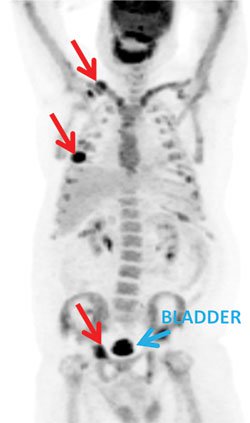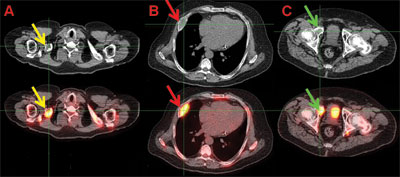Expansile, lytic and hypermetabolic bone lesions not always metastatic cancer
 Stephanie L. Lee |
 Devin Steenkamp |
A 44-year-old man was referred for evaluation of hypercalcemia. He had atraumatic rib and clavicle fractures in the setting of marked hypercalcemia and symptomatic nephrolithiasis.
His medical history included chronic kidney disease due to obstructive bilateral hydronephrosis and coronary artery disease requiring multiple percutaneous coronary interventions. His symptoms, consistent with hypercalcemia, included polyuria, nocturia, malaise, muscle weakness, depression and early morning nausea. He had no family history of endocrine disease. Physical examination was remarkable for widespread nonspecific bony tenderness on deep palpation. Proximal muscle weakness was prominent, including an inability to rise from a crouched position or walking up a step without aid. Thyroid and neck examination were unremarkable.
His serum calcium levels ranged from 10.9 mg/dL to 13.3 mg/dL during the previous year, with corresponding intact parathyroid (PTH) between 3,111 pg/mL and 4,023 pg/mL. His 25-hydroxyvitamin D level was 23 ng/mL. Serum phosphorus level was suppressed to 2 mg/dL, and serum creatinine trended up from 1.5 mg/dL to 2.2 mg/dL.

Figure 1. 18F-FDG PET scan. Multiple hypermetabolic sites in the skeleton were identified on the anterior-posterior planar image. The most active sites were seen in the right clavicle, right lateral rib and the right acetabulum (red arrows). The isotope is also seen in the bladder (blue arrow).
Images: Reprinted with permission from: Stephanie L. Lee, MD, PhD
His markers of bone turnover were very elevated, with an alkaline phosphatase of 1,344 units/L (reference: 25-100 units/L), spot urinary N-telopeptide of 311 nmol/mmol (reference: 9-60 nmol/mmol) and serum osteocalcin .300 ng/mL (reference: 9-38 ng/mL).
Extensive imaging studies were performed for the presumed diagnosis of pathological fractures. An 18F-fluorodeoxyglucose (FDG) PET/CT scan revealed hypermetabolic lesions corresponding to expansile and lytic regions in multiple ribs, vertebral bodies, iliac bones, pubic rami, acetabulum and right clavicle (Figures 1 and 2). Axial DXA bone mineral density scan showed osteopenia at both the lumbar spine (T-score –2.2) and femoral neck (T-score –2.2), and the distal radius showed marked bone loss (T-score –6.9) demonstrating preferential cortical bone loss from hyperparathyroidism (HPT). A bone biopsy of one of the larger lesions was performed with pathology consistent with osteitis fibrosa cystica (OFC).

Figure 2. 18F-FDG PET/CT scan. The axial CT scan alone (upper row) and fused the 18F-FDG PET scan (lower row) showing the hypermetabolic, expansile, cystic lesions of the bones. A) right clavicle (yellow arrows); B) right lateral rib (red arrows); and C) right acetabulum (green arrows).
A diagnosis of primary HPT was established with elevated PTH and calcium levels with nephrolithiasis, chronic kidney disease, osteoporosis and OFC with pathological multisite fractures.
Initial 99-technetium sestamibi PTH scan at an outside hospital was non-localizing, but when repeated with mediastinal views, abnormal uptake in the anterior mediastinum was seen, consistent with a 5-cm mediastinal PTH adenoma or carcinoma.
OFC was once the dominant clinical manifestation of primary HPT. With modern improvement in laboratory testing and early diagnosis, OFC has become exceedingly rare but is still seen in the developing world. Friedrich Daniel Von Recklinghausen is credited with describing the first case of OFC in 1891; however, the association with parathyroid disease was noted by Askanazy in 1904. OFC is also known as Recklinghausen’s disease of bone. The more severe cystic changes seen in OFC have been termed “brown tumors.” Histologically, these “tumors” are highly vascular and are composed of clusters of giant cells in a background of mononuclear or spindle cells with hemosiderin. OFC is characterized by PTH-mediated increase in osteoclast activity, peritrabecular fibrosis and “tunneling” resorption of trabeculae, which leads to the cystic changes and expansile, lytic features noted on imaging.
Cortical, rather than trabecular, bone loss is more prominent due to the anabolic effect of PTH on trabecular bone. However, in severe long-standing cases, trabecular bone is not spared and osteoporosis at axial skeletal sites is common. In severe forms of the disease, marked skeletal deformity, minimal trauma fractures and bony pain may result in severe disability. Primary HPT with osteoporosis or OFC would warrant surgical resection of the parathyroid adenoma, given the risk for progressive bone remodeling, fractures and potential skeletal deformity.
A case series of 51 patients in India with primary HPT and OFC were followed after parathyroidectomy with an intention to measure bone recovery postoperatively. BMD recovery was impressive and occurred early (within 1 week) and was more prominent in trabecular bone than cortical bone sites. Bone pain improved in 71% of patients. Despite improvements in BMD after surgery, re-mineralization was not universal at all bone sites and many patients never regained normal BMD after 4 years of follow-up. Brown tumors and skeletal deformity improved overall; however, radiological deformity persists and may require corrective surgery.
OFC is an increasingly uncommon presentation of primary hyperparathyroidism. The diagnosis should be suspected in patients with pathological fractures and hypercalcemia. Appropriate surgical removal of the causative parathyroid tumor has early and positive benefits on bone health, but the most severe form of HPT osteodystrophy, brown tumors or OFC, may not structurally return to normal and continue to be at an increased risk for fracture.
References:
- Agarwal G. Surgery. 2002;132:1075-1083.
- Kearns AE. Mayo Clin Proc. 2002;77:87-91.
- Pai M. Clin Nucl Med.1997;22:691-694.
For more information:
- Stephanie L. Lee, MD, PhD, is associate professor of medicine; associate chief, section of endocrinology, diabetes and nutrition; and associate professor of medicine at the Boston Medical Center.
- Devin Steenkamp, MD, is a Fellow in Endocrinology at Boston Medical Center.
- Disclosure: Dr. Lee and Dr. Steenkamp report no relevant financial disclosures.
